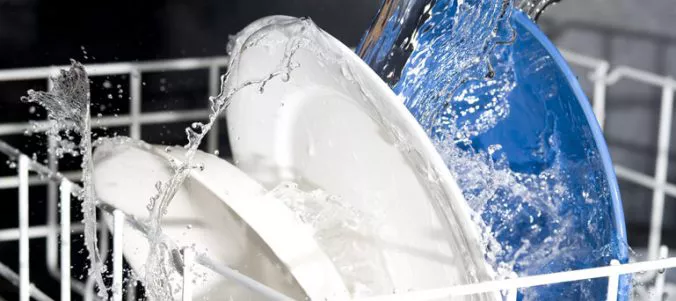
A newly married young man had to deliver a short presentation to a group of middle school students one day. Here’s how he started his talk:
“Since I got married, I’ve discovered that there are two types of people in the world: The ones who think bowls should go in the bottom dishwasher rack and those who think bowls should go in the top rack.”
While the ubiquitous dishwasher saves us a lot of time cleaning up after meals, there are certain aspects of its loading that can become contentious issues in a family. In addition to the “proper rack for bowls controversy” there is also the age-old “rinse-no-rinse” debate.
Let’s take a few moments and try to sort out these disputes and share a few tips and general principles about the proper care and feeding of your dishwasher.
Remember running through the sprinklers when you were a kid? You want your dishwasher spray to hit all your loaded items just like you wanted to get blasted by the sprinkler on a hot summer day.
To accomplish this, don’t load items on the bottom rack that will block the spray from reaching the top. For example, if you put a mug on the bottom, it will act like a shield and create a “spray shadow” that keeps water from hitting items above it.
Also, the spray is generally starting in the middle and being directed out to the side walls of the dishwasher. Therefore, face items with their dirty sides toward the middle. This means that plates on opposite sides of the dishwasher will be “facing” each other.
You want all the surfaces of your glasses, plates, bowls and flatware to be dry at the end of the dishwasher cycle. This has a few implications.
First, load lightweight, plastic items to prevent them from flipping over and acting as buckets during the rinse cycle. You know they’ll collect dirty water that has better than a 50-50 chance to be spilled over your clean dishes when start to unload.
Further, some of your glasses and mugs have indentations on top that collect water. Load these so they tilt slightly. That way the water will not puddle up so badly.
Many dishwashers have small built-in garbage disposal units that grind up any food that is left on plates. Yay! However, if yours doesn’t, be sure to keep the screen filter clean. If there’s a wet-dry vacuum cleaner in your house, use that to suck up all the gunk. You may have a removable filter. If so, take it out and wash it with soap and water.
In hard water areas, the nozzles will eventually clog up – either fully or partially. The spray arms are usually not difficult to remove, often they just have a screw that can be loosened by hand. Periodically remove the spray arms and soak them in white vinegar to dissolve the hard water deposits. You can also use something like picture hanging wire to “ream” them out, if necessary.
White vinegar can also be used to clean the interior of your dishwasher. Toss in a cup and run it unloaded on its heavy cycle. Follow that up with a cup of baking soda. Leave the baking soda strewn about the bottom overnight and then finish off with another empty cycle.
Good dishwashers today do a fine job without pre-rinsing most items. Some baked-on food may cause a problem, but we’re always surprised how robust good dishwashers are today.
If you’re in the habit of pre-rinsing everything, why not experiment one week and see what kind of results you get? However, if you have a dishwasher with an old screen mesh filter that easily clogs up, be careful about leaving hunks of food on your dishes.
Finally, what about the bowl argument that kicked off this article? Frankly, they can go either on top or on bottom, especially if they are shallow enough. Put deep bowls on top, for sure.